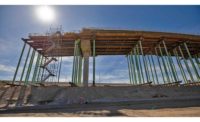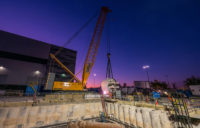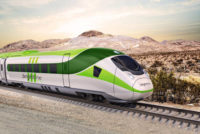Many areas in the Southwest have escaped the widespread government-mandated shutdowns from the coronavirus pandemic, but several key regional projects have been halted, and planned starts for others are in jeopardy, as has been the case across the country. Total construction starts nationwide declined 5% from February to March, according to a report from Dodge Data & Analytics. But that modest decline may be somewhat misleading.
“Most of the stay-at-home orders and construction moratoriums were not instituted until the last week of the month and into April,” said Richard Branch, chief economist for Dodge Data & Analytics. “Therefore, April construction starts are likely to be a very different story. April’s starts data will be the first true indication of how the crisis will impact the construction industry.”
Nevada
The entire Las Vegas Strip was shut down more than a month ago because of the coronavirus, idling tens of thousands of resort workers. The expected economic fallout from the pandemic led the Brookings Institution to warn that Las Vegas stands to be hit harder financially than any other large U.S. city. Nevada’s unemployment rate went from 3.6% in February to 6.3% in March, the largest percentage-point increase of any state, according to the Bureau of Labor Statistics.
Area leaders have been vocal in their disagreement about how and when to reopen the state’s casinos, hotels and entertainment venues. Las Vegas Mayor Carolyn Goodman said on April 23 that she favors reopening the city with few guidelines in place, while Gov. Steve Sisolak (D) and others favor a more cautious approach to lifting restrictions. Nevada officials reported more than 4,000 cases of COVID-19 and 187 deaths as of April 23.
Construction continues on the new NFL stadium in Las Vegas and all major building projects in the area except for two. Madison Square Garden Co. halted work a month ago on the $1.7-billion MSG Sphere, intended to be the world’s largest spherical building. The 17,500-seat arena being built just east of the Las Vegas Strip is a partnership with Las Vegas Sands. It broke ground 18 months ago and is about half finished. Projects to be completed along with the MSG Sphere are a new Las Vegas Monorail stop at the arena and a 1,000-ft-long pedestrian bridge to the Venetian resort. Construction had yet begin on those projects when work was halted on the Sphere. In its March 31 announcement, Madison Square Garden Co. cited supply chain disruption but offered no guidance on when the project would resume.
“April’s starts data will be the first true indication of how the crisis will impact the construction industry.”
– Richard Branch, Chief Economist, Dodge Data & Analytics
Work also is stopped on the Drew, a resort project on the north Strip that topped out in 2008, when it was known as the Fontainebleau, then shut down shortly after as the Great Recession took hold. The property sat idle until last year, when work resumed under the ownership of New York real estate developer Steve Witkoff, who purchased the property and renamed it in 2017. Work resumed in 2019, and Witkoff announced in January 2020 that the Drew had secured a construction loan that would allow it to finish by late 2022.
Meanwhile, construction continues on the $2-billion Allegiant Stadium, where the NFL’s Las Vegas Raiders are scheduled to begin play this fall, despite two workers at the site having tested positive for COVID-19 in early April as well as an administrator with a trade partner who visited the site on April 7. However, the administrator was not symptomatic at the time, and contracting officials say the areas he visited have been thoroughly sanitized.
The domed stadium’s ETFE roof was completed in mid-April amid increased safety precautions by the joint venture contractor Mortenson-McCarthy, including staggered starting times, mandatory social distancing and additional sanitation and cleaning.
“So far, I have not heard of delays to the schedule,” says Frank Hawk, a United Brotherhood of Carpenters official who oversees the union in Nevada. Developers say the stadium is still set for a late July or early August completion.
Work also continues on the $980-million expansion of the West Hall at the Las Vegas Convention Center and the companion $53-million drilling of underground transportation tunnels underway by Elon Musk’s Boring Co. Both projects were spared $79 million in budget cuts imposed by the convention authority responsible for the work. However, the planned renovation of four other exhibition halls, slated to cost nearly $540 million, will likely be delayed at least two years, convention authority officials said.
Construction on the $4.3-billion Resorts World Las Vegas project continues even after a third worker tested positive for COVID-19 on April 6. The first two cases were reported in March. Company officials said they are complying with guidelines set forth by the Centers for Disease Control and Prevention and OSHA, and common areas and walkways were “periodically shut down and routinely sanitized to ensure the entire jobsite remains safe for workers,” according to a news release.
On April 16, the 777-room Circa hotel-casino project in downtown Las Vegas, which is about halfway done, reported its first case of a worker testing positive for COVID-19. Contractor McCarthy Building Cos. issued a statement that the area in which the worker was stationed had been shut down and sanitized and the worker is in isolation and won’t return to the jobsite until cleared by health care workers. The website for The D hotel-casino, also a property owned by developer Derek Stevens, says Circa will open in December.
A spokesman for the Nevada Dept. of Transportation said work continues on all of its projects as scheduled.
— By Doug Puppel in Las Vegas
Arizona
In Arizona, where the number of reported COVID-19 cases reached 5,251, with 208 deaths, as of April 23, construction has been deemed an essential service by Gov. Doug Ducey (R) and work continues on most major projects there, including those for the Arizona Dept. of Transportation.
“The state transportation system is essential to the delivery of people, products and services across Arizona,” said ADOT spokesman Tom Herrmann, via email.
However, some sectors have been hit harder than others. The postponement of elective surgeries means that health care facilities have had to manage their cash flow more carefully. “The industry is getting crushed,” says Jim Swanson, president and CEO of Kitchell. “Many higher education and public-sector projects are ongoing, especially in California, whereas in Arizona, some of these are on hold.”
Most contractors across the state report strong backlogs. “The bigger contractors have backlogs 12 to 14 to 16 months out, so work is still good,” says Anthony J. Lamanna, program chair for the Del E. Webb School of Construction at Arizona State University. “But we expect a donut hole in 12 months or so. Private owners are not starting new projects, and for public projects, there are not a lot of RFPs right now.”
“Private owners are not starting new projects, and for public projects, there are not a lot of RFPs right now.”
– Anthony J. Lamanna, Program Chair, Del E. Webb School of Construction, ASU
Many residential contractors and trades also have solid backlogs that may help them weather the pandemic. “With the new home build cycle of many months, COVID-19 hasn’t affected the new construction side too much yet. This work is backlog that was sold before the crisis began,” says Michael Brewer, CEO of Ben Franklin Plumbing AZ, Phoenix, and current president of the American Subcontractors Association of Arizona. “We have not had to lay off any of our 400 employees in Phoenix and Tucson. But we’ve made a ton of adjustments. Overall, about 20% of our employees are now working at home remotely, with the remainder in the field in different capacities.”
However, Lamanna says more slowdowns and layoffs may result if major supply chains are disrupted. “A manufacturer may not be considered an essential service in its area, so when they close, the items may be hard to get,” he says.
Timely delivery of materials also requires more strategic planning than in the past. “The pandemic has shifted our focus from traditional long-lead materials and equipment planning to any material or equipment that is not sourced domestically,” says Mike Godbehere, president, GCON Inc. “If it is sourced domestically, [we now must determine] is it part of the essential services of that particular state?”
In addition to concerns about supply chains, regional contractors have been forced to enhance safety practices on their jobsites, even though they had strong safety protocols in place before the pandemic hit.
“The Arizona commercial construction industry’s top priority has always been worker safety,” says Tom Dunn, president, Arizona Builders Alliance. “Expanding the possible safety concerns to protect workers on the jobsite from COVID-19 exposure and spread was simply an expansion of safety protocols to that of the CDC suggestions.”
Those protocols include more frequent communication with trade partners and owners. “We have established staggered shifts, limiting how many people are in the lunch tents, new cleaning protocols such as wiping down tools and extra cleaning. At some sites, we do thermal scans,” says Rosendin’s Larry Beltramo, who is also the national president of NECA.
However, some firms have added new processes. “On our jobsites, we have introduced a new protocol of interviewing each subcontractor employee as they come to work,” says Justin Newman, president, hardison/downey. “This is a short wellness check to ensure there’s no fever or other COVID 19-related symptoms.”
Some big questions remain: How long will the pandemic go on and what will the industry look like after it subsides? “I think automation and robotics are where we’re headed, such as drones for surveying,” Lamanna says. “I also think we have to look back at what happened after the last recession. A lot of mid-career people left and never came back.”
Most contractors are cautious about near-term prospects. “Our concern is centered around the lack of projects breaking ground and the slowing or stopping of projects in the planning and design phases,” Godbehere says. “This will cause a ripple effect that will start to be seen with lower backlog and work for contractors in eight to 10 months.”
— By David Brown in Phoenix
New Mexico
The state has benefited from a sustained petroleum boom over the past few years. Oil production in 2019 reached nearly 328 million barrels, more than double the 2016 output. However, the coronavirus, coupled with the collapse of oil prices, forced cuts in production and created potential revenue shortfalls. Those factors forced cutbacks even before the pandemic hit.
Gov. Michelle Lujan Grisham (D) trimmed nearly $110 million worth of public works projects from the state’s budget on March 11. The move followed an earlier veto of a separate $50-million transportation spending measure. Grisham also deleted approximately 530 projects from the budget for the coming fiscal year. Cuts included improvements to schools and social services facilities, tribal building repairs, road renovations and street signs.
But during the pandemic, construction in New Mexico also has been considered an essential service, especially highway and bridge work. “There have been some delays with a few construction projects due to supply chain delays specifically related to COVID-19,” says Marisa Maez, communications director at the New Mexico Dept. of Transportation. “But we are not postponing any projects. We plan to move forward with those that are shovel ready and slated to begin soon. We are doing inspections via video.”
“The challenge we have is finding support services for our crews when they have to travel out of town to work.”
– Gia Espinoza, Executive Director, ASA of New Mexico
Firms are taking great care with jobsite protocols. “Processes our members are implementing are staggered schedules, split shifts, working remotely, employers monitoring employees for symptoms and exposures, layoffs and jobsite closures,” says Gia Espinoza, executive director, ASA of New Mexico, in Albuquerque. “In some instances, New Mexico subcontractors are choosing to close their businesses completely for their own protection.”
Other companies are finding unexpected obstacles to completing projects. Denise Mello, president of Sealant Specialists Inc. in Albuquerque, says, “The challenge we have is finding support services for our crews when they have to travel out of town to work. For example, we are at the completion stages of a hospital about 200 miles from Albuquerque, and we are finding it difficult to find lodging for our crews because hotels and motels are restricted to 25% capacity.”
Some of the state’s leaders worry about a coming decline in construction employment. “New Mexico had the largest 12-month employment percentage gain at 8.8% from February 2019 to February 2020,” says Kelly Roepke-Orth, CEO, AGC of New Mexico. “There is always concern that an increase in project cancellations and a drop in demand will result in massive job losses.”
— By David Brown








Post a comment to this article
Report Abusive Comment